'Predators': Robert Rodriguez Gets to the Chopper
by Abe Sauer
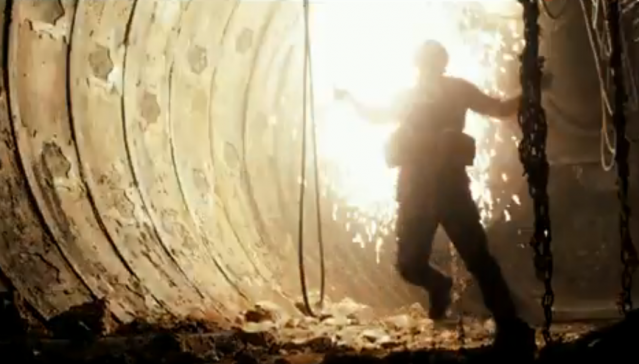
Those of us who were moviegoers in 1987 have a very soft spot in our heart for Predator, the magnificent dual-governor-to-be casted scifi-horror-monster flick. Today, two Predator fans take a look at the sequel, the imaginatively titled Predators. Earlier we heard from horror connoisseur Melissa Lafsky; now here’s action, gun and script expert Abe Sauer, who reveals that Predators actually could have ended worse.
“Reboot.” “Update.” “Brand recognition.” These terms always accompany the announcements of Hollywood’s latest try at turning nostalgia into dollars. After The A-Team and Clash of the Titans, RoboCop, Red Dawn, Highlander, Total Recall, Romancing the Stone, Red Sonja, The Fall Guy, The Equalizer, Footloose, The Black Hole, Death Wish, Escape from New York, and Tron are just a few of the in-the-works “reboots” of 1980s “properties.” Predators, in theaters now, is not a reboot. Then again, how was a studio going to make a “grittier, darker, more real” Predator for “our modern reality” when the predators of our modern reality are far more scary than the 1980s sic-fi headliner could ever hope to be? Similarly cloaked from plain sight, today’s predator is the neighbor waiting to rape your child or an unexpected, unmanned drone death from above.
Some spoilers follow
Released in 1987, Predator was directed by John McTiernan, who went on to direct Die Hard, the best straight-up action film of the 1980s (and maybe ever). It is the only action script commonly taught in screenwriting programs. Like Die Hard, Predator is a deeper film than its IMDb page suggests. While often lazily compared to other show beef action movies of the era (Roger Ebert wrote that the film “begins like ‘Rambo’” and Janet Maslin in The New York Times wrote “’Predator’’ starts out as a second cousin to ‘Rambo’’ and ‘’Missing in Action…’”), the film has far more in common with Jaws and Apocalypse Now. The scene where the soldiers fire blind, wild and panicked into the jungle at an invisible, unknown enemy mirrors the tiger sequence from Apocalypse. That, in 1987, Predator was seen by many to be a Vietnam allegory has been largely forgotten. In Predators, Robert Rodriguez & Co. makes his own nod to Coppola’s tale, but in characteristic fashion, it’s just a big fat joke.
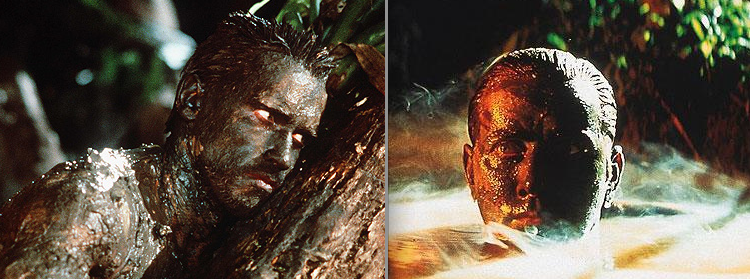
Predator was also subversive. At a time when Arnie and his ilk regularly fought Russians and terrorists, Predator’s underlying message was that Reagan-era agencies like the CIA were no better. It may have been morning in (Central) America, but for Mac, Blain, Hawkins, Poncho, Billy and Dutch, that fresh day’s sunlight was not visible through the tree canopy. More than any studio marketer could wish for, Predator debuted in theaters just as New York Times headlines read “Superiors Knew of Contra Help, C.I.A. Man Says.”
The Nimród Antal-directed Robert Rodriguez Presents: Predators is a sequel. But it is no true sequel. It is pastiche. Entire scenes are lifted more or less wholesale from the original and plunked into place, held together with a wink. Seemingly the only detail Rodriguez forgot to mimeograph was the wristwatch; while Adrien Brody sports a Hamilton Below Zero, one would have expected to see Seiko’s H558, Arnold’s favorite movie watch. It’s a detail one expects Rodriguez to know.
Otherwise, Predators borrows so heavily from the first film that any criticism almost needs to address it both as a sequel and as a reboot.
Has Rodriguez really worked on this project, on and off, for 15 years? It doesn’t show in the final product, which, despite all the junket comments to the contrary, borrows very little from the 1994 Rodriguez script. In interviews, Rodriguez typically claims that his original script was not produced because the technology was not yet available. It is more likely it was not produced because it is bullshit, exhibiting all the worst tendencies of the action genre sequel: Bigger, Faster. MORE. One scene in Rodriguez’s original script, set on a planet named Arkus 6, references “teen predators” and Harley-Davidson-like predator “Cyclesleds” which appear in an action sequence, only proving Mr. Rodriguez enjoyed a little “homage” even in his youth. The script stars the Arnold character “Dutch” and its difference from the original Predator can best be compared to the difference between the excellent Pitch Black and its insulting sequel The Chronicles of Riddick.
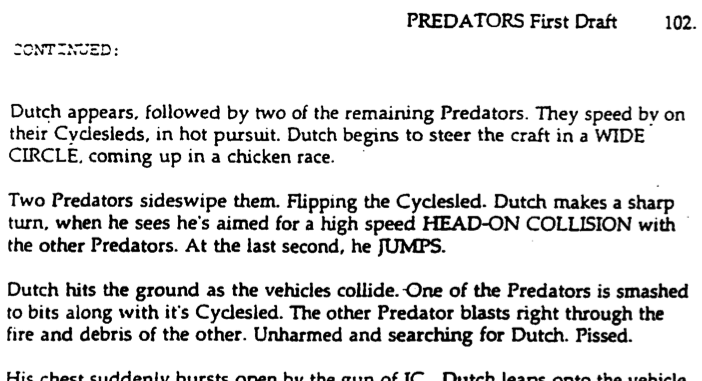
The Rodriguez script that did end up being the Predators film now in theaters is a major improvement on its ancestor. Yet it suffers the same miscalculation made by all subsequent Predator films: an assumption we want to know more about the Predators. It’s a mistake George Lucas made with Boba Fett, tragically believing the character’s popularity invited deeper plumbing of the bounty hunter’s persona. The misjudgment gave us a Fett-heavy prequel shambles.
Rodriguez’s Predators makes the same error, giving us more predator weapons, predator dogs, predator falcons and predator culture. And, of course, more predators. Too many predators. Too much variety. The second version of Rodriguez’s Predators script contains the lines “This is not your father’s Predator” and “Think Predator on steroids.” At the same time, Antal and Rodriguez have talked in interviews about wanting to humanize the predators. It’s Bigger. Faster. MORE. Mostly MORE. The original single predator handily eliminated a team “accused of being the the best” in one 24-hour period. Now we are to believe a rag-tag bunch of killers is going to fight off a whole hunting party of predators, their predator falcon and predator dogs? Certainly, Yakuza and Mexican cartel hit-men are true bad-asses, but today’s gentrified Yakuza are having enough trouble dealing with senior citizens, let alone alien masters of slaughter.
One specific example of how Predators tries for MORE but achieves less is the Yakuza character’s death, a scene clearly meant to replicate the original in which Billy gives up his flight, turns around on a log bridge, throws away his gun, draws his machete, and prepares to battle the beast, mano-a-mano. In the original, we never see Billy die, his scream just fills the jungle. In Predators, the Yakuza compatriot similarly gives up flight, disrobes and turns to face his sure death, a sword as his only weapon. This nod to nostalgia works until the scene continues onward, ending with a comical thrust-perry fencing duel that sucks all the tension and mystery out of the fun. The result is that these borrowed bits, these Predator but “on steroids” moments, only serve to exemplify the mediocrity of the homage.

Predators takes place on one of those convenient planets so often found in middling sci-fi, where alienness is confined to occasional prop-department contribution. It is also an open planet. Far too open. Predators opens in the air, with Royce, our new Dutch, falling, inexplicably, through the atmosphere, the wind in his hair. Even when the action movies into the jungle, rays of sunshine still find a way in. Tree trunks are tall and the foliage is largely at a distance. The jungle of Predators would make a nice place for a hike.
The original Predator’s atmosphere was a sweltering, equatorial nightmare that the audience felt in the seats, where bugs bit and damp clothing clung. Predator’s use of the jungle to create claustrophobic tension mirrored the use of the cramped ship in Alien, a film Predator itself could be accused of transcribing. For the characters, who visibly poured sweat throughout the film, and who never glimpsed the sky, Predator was a fever dream from which death might be, eventually, welcome. That film piled on the claustrophobia from the start, opening at dusk, moving tighter and tighter, from the cigar-smoke-filled low-ceilinged office shack to the op-red nighttime chopper ride. The only view we ever get outside the curtain of the jungle was the final, stupefied ride away into the numb void, where a deep breath was allowed and the expanse is finally visible, if pointless.
One of the seldom mentioned but never forgotten breakout stars of Predator was the weaponry. For gun buffs, Predator was a smorgasbord of Heckler and Koch appetizers with extravagant main courses. The film took run of the mill M16s and then strapped shotguns and grenade launchers beneath their bellies. The film also employed dramatic fire suppressors, which burped stars from the end of the barrel, turning normal gunfire into fireworks. Predators duplicates its predecessor’s gun-obsession not just with the mini-gun, but also a vast array of other exotics. From its own double H&Ks; to the Blaser sniper rifle to the run of the mill Baretta capped with a dramatic fire suppressor, Predators gets the NRA porn part right. (It’s worth noting that 1990’s Predator 2 got this right as well, loading its L.A.-as-war-zone scenes with overly-theatrical laser sight attachments, Desert Eagles, Steyr AUGs and Mossbergs.) Most importantly, Predators puts the AA-12 in the hands of its star, Brody. The AA-12 assault shotgun has a distinct look and a pedigree much deeper than its smooth and simple exterior. The New Yorker even deemed the weapon worthy a long profile last year.
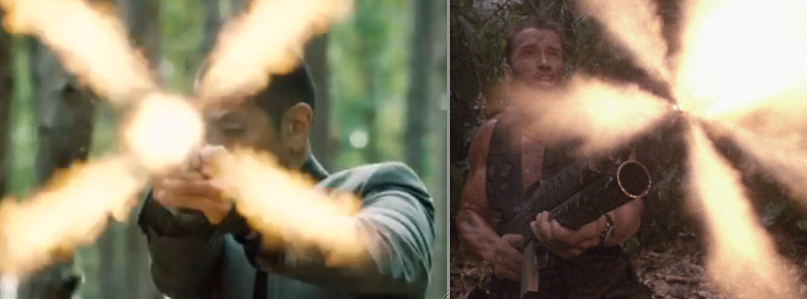
And of course, there was Predator’s unforgettably fun mini-gun (“Old Painless”) toted by Blain (Jesse Ventura). It’s a weapon whose extravagant idiocy has since become a staple of action grotesquerie, from Terminator 2 to the upcoming Machete (another Rodriguez film, the trailers for which already exhibit numerous recreations of bits from the director’s 1995 film Desperado, which was itself a remake of El Mariachi). Too bad Predators’ ode to the original’s mini-gun (a M134 instead of Ventura’s modified GE M134) is wasted in the first minutes, before the audience has an opportunity to anticipate its unboxing.
Like Predator, Predators also eschews CGI effects for old-school rubber-mold. It is a bold, brave bet for a modern action film to make. The Predator character could easily have been the Silly Putty-looking Ghost Rider. For this rare act of restraint alone, Predators deserves some credit; it’s credit Rodriguez hasn’t missed taking.
A side note about Danny Trejo: “That Guy” actor Danny Trejo shows up here, the reborn “El Scorpio” character from Predators 2, double-fisting machine guns and all. It’s no surprise to see him. Rodriguez has used him regularly, including in both Desperado and its sequel Once Upon a Time in Mexico, even despite Trejo’s character having died in the first film. It’s also no surprise to see him playing a character with no surname (Cuchillo). Since his 1995 star-making turn in Heat (in which he played a character named just “Trejo”), Trejo has had well over 100 roles, almost all as characters like Razor Charlie, Poacher, Scarface, Fred, Collins, Pierce, Vito, Jumpy, Slim, Machete, Pedro, El Jefe, Bob, Manny, El Patron, Cucuy, Raul, Papi, Harold, Rondo, Apache, Fury, Roy, Creek, Shady Chuck, Priest, Albert, Junk, El Chivo, Clint, Capone, Manolo, Perry, Barro, Captain Podrido, Mario, Esteban, Crazy Joe, Jimmy, and Tortuga. He has played a character with the one-word name “Hector” no fewer than five times. Brody’s character should have been killed early on with Trejo finishing out the film. Predator vs. Machete, a truly unique sequel.
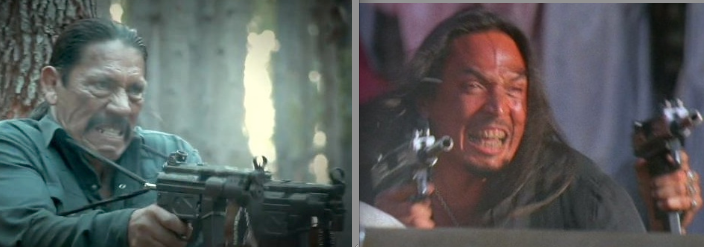
Despite victories with the guns, CGI and, Danny Trejo, Rodriguez and Co. get a big thing wrong, and it’s not Laurence Fishburne, who, looking awfully paunchy for having spent decades surviving on scraps, appears in a predator git-up reminiscent of Princess Leia’s Boushh bounty hunter disguise.
No, in all that has been copied from the original, what goes most wrong is a shame, because from all the publicity circuit raving both Rodriguez and Antal have done in the last two weeks about the original, it seems they fully recognize it.
It may seem antithetical, but the original Predator wasn’t successful because of the action or the special effects or the monster or even Arnold. It was about the give and take between the characters. The popularity of the whole film rests on the first 30 minutes. It is in these 30 minutes, from the chopper ride to when Blain breaks out Old Painless, that Predator’s popularity rests. It is all before the first bullet is fired. In fact, the 120 seconds in the helicopter early on in the film does more to establish the characters than most action films manage in 100 minutes. This chatter includes two great mood-lightening jokes.
Those jokes in the helicopter, in the first minutes of the film, are delivered by Shane Black, the famed screenwriter of Lethal Weapon, Last Boy Scout, Long Kiss Goodnight, Kiss Kiss Bang Bang, and the under-appreciated Last Action Hero. He plays Hawkins and after these jokes he will not speak again for the rest of the film. That we’re endeared to him in those moments is all on the strength of the dialogue.
This dialogue not only invests the audience in the cast but also makes us envy them. That opening has the language and cadence of every high school team on a bus on their way to every away game. The attraction to seeing Predator with your buddies is that, in your wildest imagination, that is you and them. Also, Predator’s humor was equitable, with characters giving as good as they got. Predators is hopelessly humorless. So much so that Topher Grace was hired as a humor mercenary to add snarky Eric Foremanisms at the expense of everyone, including the film.
That both Rodriguez and Antal failed to realize this is a pity. In numerous interviews both retell the tale of first seeing Predator in the theater, with buddies. Rodriguez says he saw it with his elder brother, who was a body builder at the time. Describing his first Predator viewing, Antal said, “Fourteen years old. Avco on Wilshire. Guido Martini, John McMann, Sean Ender, and Chris Alright and I. And I walked out going ‘Oh! Whoa!’” Antal was 13. Rodriguez was 18. (Rodriquez and I share the same birthday, by the way-June 20.)
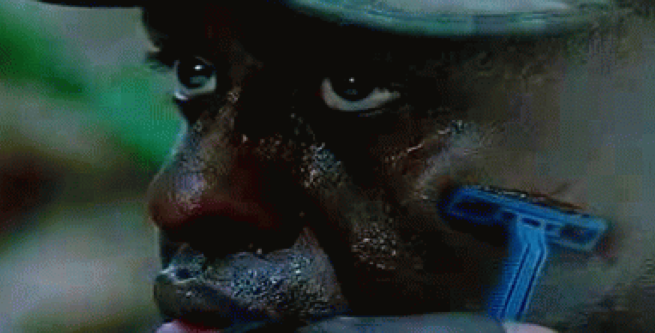
For Predators, Brody spent time preparing for the role by sleeping in the jungle, boasting, “I was isolating myself and studying tons of military manuals and learning tactics. I was spending time alone in the jungle.” Meanwhile, Rodriguez brags about preparing the backstories of all the characters. He tells of how the sniper character became what she is because of her rare ability to lower her heartbeat. But that cannot make up for the lack of character development onscreen. Having slept in the jungle a few times and being able to sit in a captain’s chair and excitedly talk about how the Yakuza character was born 1,000 years too late, and should have been a samurai, is nothing next to Bill Duke running a razor all over his sweaty head… and then breaking it. What the hell was that? That was awesome.
It’s telling that neither the fanboy community, nor Rodriguez, nor Antal, nor any marketing material even suggests that this film is better than, or even on par with, the original. Expectations are low, with “not an embarrassment” a totally acceptable measure of success. Predators is not an embarrassment. But the best that can be said about Predators is that it deserves a gold star for effort and could have been far, far worse. Case in point, the updated Rodriguez script for the current Predators includes an alternate ending page (below) which would have made Predators the most preposterously disingenuous action sequel of all time, a total bullshit psych-job.
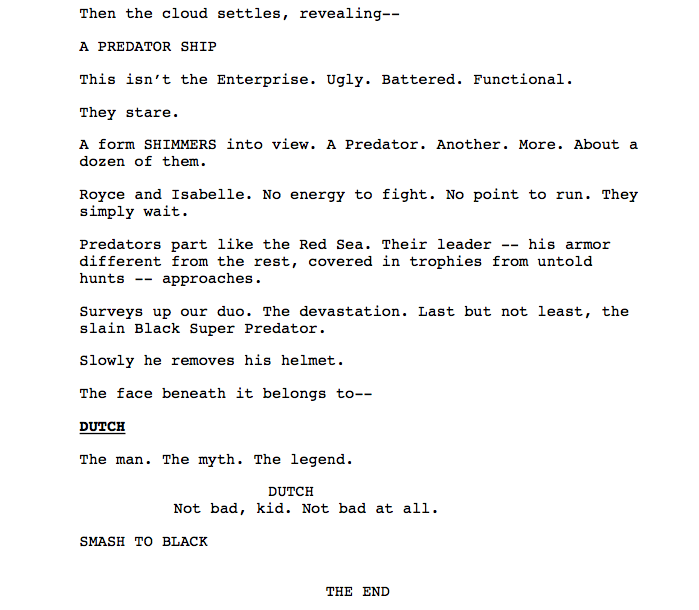
In the end, where Predators is most like the original, and most successful, is as a vehicle for its star. Just as the original was seen in its time as a vehicle for Arnold, so does today’s Predators exist solely as a vehicle for Robert Rodriguez. If there is one thing Rodriguez is better at than making movies it’s talking about making movies. Next up? Robert Rodriguez Presents: Red Sonja.
Not unlike the predator culture he has gone on about recently, Rodriguez is a trophy hunter. It is no stretch to imagine him and Tarantino sitting on a couch, shooting the shit about which genre from their youth to plunder next, while nearby lurks a life-size predator from the prop department, modified to hold a tray for their drinks.
Abe Sauer really, really likes Predator.
